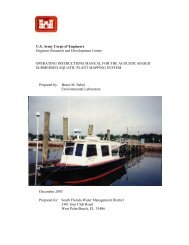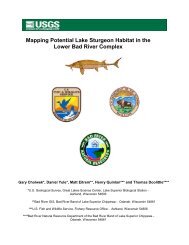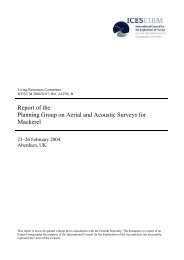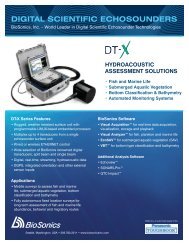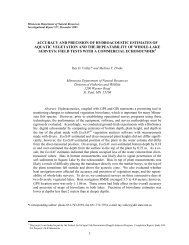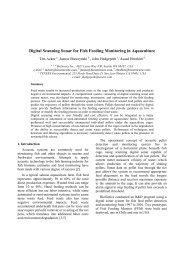Target Strength of Southern Resident Killer Whales ... - BioSonics, Inc
Target Strength of Southern Resident Killer Whales ... - BioSonics, Inc
Target Strength of Southern Resident Killer Whales ... - BioSonics, Inc
You also want an ePaper? Increase the reach of your titles
YUMPU automatically turns print PDFs into web optimized ePapers that Google loves.
Code:46.2008-final-Feb9<br />
body <strong>of</strong> whales, which are complex, composed <strong>of</strong> layers with very different physical and acoustic<br />
properties. Even when the three-layer model is simplified by not considering the skin and muscle, it<br />
might still provide a better estimate <strong>of</strong> acoustic reflectance than the two-layer model with large<br />
impedance mismatch used by Urick. These considerations might explain the unexpectedly low TS<br />
measurements Au’s 1996 obtained for bottlenose dolphin and might also help explain the relatively low<br />
killer whale at 200-kHz frequency.<br />
As with any other experiment, unavoidable measurement errors are always a factor affecting<br />
estimates. For example, the pulse length <strong>of</strong> the Biosonics DT-X system is 400 μs (user selectable from<br />
0.1 ms to 1.0 ms), which is likely too short to insonify an entire whale; this is most certainly the case<br />
when the whale is approaching or swimming away from the sonar. In that case, the TS <strong>of</strong> killer whale at<br />
tail or head aspects would be underestimated. The TS <strong>of</strong> an underwater object is likely to be less at short<br />
ranges than at long ranges. One reason is that a very directional active sonar signal fails to insonify the<br />
entire target. Another reason is the target reflection as echo usually acts differently from point source,<br />
depending on the size and shape <strong>of</strong> the underwater object.<br />
The trajectory <strong>of</strong> whale motion in Figure 1 and the whales’ speed as a function <strong>of</strong> time in Figure 3<br />
show that during the 3-min sonar observation period, the whales first were approaching the transducer for<br />
about 20 s and then moved closest to the transducer for about 45 s. In the final 20 s, the whales moved<br />
away with increased speed. Similar behavior was observed also in studies by both Love (1971) and<br />
Lucifredi and Stein (2007) with center frequencies <strong>of</strong> 20 kHz and 23 kHz for humpback whales and gray<br />
whales. They observed that the whales approached the transmit site, slowed down or even stopped to<br />
listen for a while, and then moved on with increased speed. It is generally considered safe to use<br />
echosounders at frequencies above 180 kHz in the vicinity <strong>of</strong> marine mammals because this is out <strong>of</strong> the<br />
hearing range <strong>of</strong> most marine mammals. However, the recent study <strong>of</strong> a signal leakage <strong>of</strong> active sonar<br />
15



